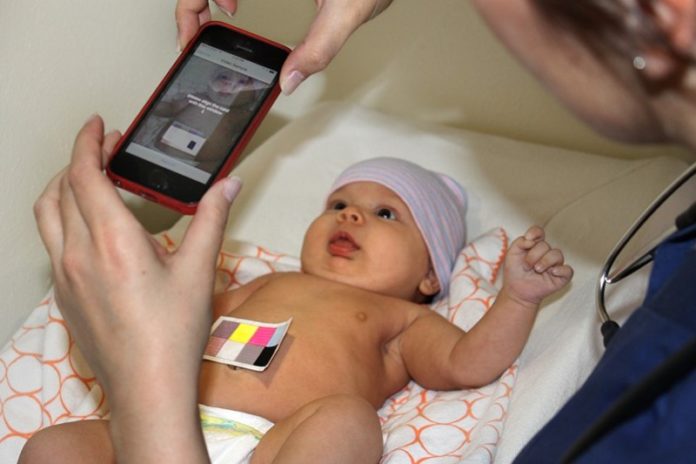
Newborn jaundice: It’s one of the last things a parent wants to deal with, but it’s unfortunately a common condition in babies less than a week old.
Skin that turns yellow can be a sure sign that a newborn is jaundiced and isn’t adequately eliminating the chemical bilirubin. But that discoloration is sometimes hard to see, and severe jaundice left untreated can harm a baby.
University of Washington engineers and physicians have developed a smartphone application that checks for jaundice in newborns and can deliver results to parents and pediatricians within minutes. It could serve as a screening tool to determine whether a baby needs a blood test — the gold standard for detecting high levels of bilirubin.
“Virtually every baby gets jaundiced, and we’re sending them home from the hospital even before bilirubin levels reach their peak,” said James Taylor, a UW professor of pediatrics and medical director of the newborn nursery at UW Medical Center. “This smartphone test is really for babies in the first few days after they go home. A parent or health care provider can get an accurate picture of bilirubin to bridge the gap after leaving the hospital.”
The research team will present its results at the Association for Computing Machinery’s International Joint Conference on Pervasive and Ubiquitous Computing in September in Seattle.
The app, called BiliCam, uses a smartphone’s camera and flash and a color calibration card the size of a business card. A parent or health care professional would download the app, place the card on her baby’s belly, then take a picture with the card in view. The card calibrates and accounts for different lighting conditions and skin tones. Data from the photo are sent to the cloud and are analyzed by machine-learning algorithms, and a report on the newborn’s bilirubin levels is sent almost instantly to the parent’s phone.
“This is a way to provide peace of mind for the parents of newborns,” said Shwetak Patel, a UW associate professor of computer science and engineering and of electrical engineering. “The advantage of doing the analysis in the cloud is that our algorithms can be improved over time.”
A noninvasive jaundice screening tool is available in some hospitals and clinics, but the instrument costs several thousand dollars and isn’t feasible for home use. Currently, both doctors and parents assess jaundice by looking for the yellow color in a newborn’s skin, but this visual assessment is only moderately accurate. The UW team developed BiliCam to be easy to use and affordable for both clinicians and parents, especially during the first several days after birth when it’s crucial to check for jaundice.
Jaundice, or the yellowing of the skin, can happen when an excess amount of bilirubin collects in the blood. Bilirubin is a natural byproduct of the breakdown of red blood cells, which the liver usually metabolizes. But newborns often metabolize bilirubin slower because their livers aren’t yet fully functioning. If left untreated, severe jaundice can cause brain damage and a potentially fatal condition called kernicterus.
The UW team ran a clinical study with 100 newborns and their families at UW Medical Center. They used a blood test, the current screening tool used in hospitals, and BiliCam to test the babies when they were between two and five days old. They found that BiliCam performed as well as or better than the current screening tool. Though it wouldn’t replace a blood test, BiliCam could let parents know if they should take that next step.
“BiliCam would be a significantly cheaper and more accessible option than the existing reliable screening methods,” said Lilian de Greef, lead author and a UW doctoral student in computer science and engineering. “Lowering the access barrier to medical applications can have profound effects on patients, their caregivers and their doctors, especially for something as prevalent as newborn jaundice.”
The researchers plan to test BiliCam on up to 1,000 additional newborns, especially those with darker skin pigments. The algorithms will then be robust enough to account for all ethnicities and skin colors. This could make BiliCam a useful tool for parents and health care workers in developing countries where jaundice accounts for many newborn deaths.
“We’re really excited about the potential of this in resource-poor areas, something that can make a difference in places where there aren’t tools to measure bilirubin but there’s good infrastructure for mobile phones,” Taylor said.
Within a year, the researchers say BiliCam could be used by doctors as an alternative to the current screening procedures for bilirubin. They have filed patents on the technology, and within a couple of years hope to have Federal Drug Administration approval for the BiliCam app that parents can use at home on their smartphones.
Related research paper can be found at: http://homes.cs.washington.edu/~mayank/BiliCam.pdf
Story Source:
The above story is based on materials provided by University of Washington. The original article was written by Michelle Ma. Note: Materials may be edited for content and length.
